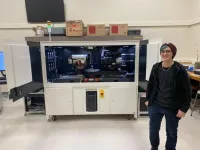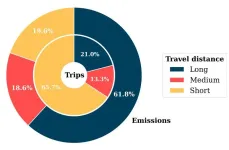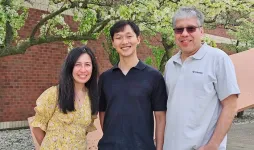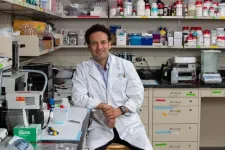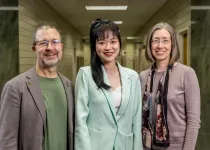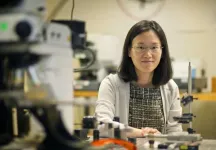(Press-News.org) Interdisciplinary researchers in Illinois, the U.S. and around the world can advance their projects with the Beckman Institute for Advanced Science and Technology's new Zeiss Xradia 630 Versa micro-CT scanner, the first of its kind with life science applications in the U.S.
Computed tomography, or CT, is an imaging technique that involves capturing a series of cross-sectional X-ray scans of an object or sample — be it a material like concrete or a biological sample like an insect or human body. Stacked on top of one another, the images non-invasively reconstruct the subject in 3D from the inside out. Microscopic computed tomography, or micro-CT, helps researchers reconstruct subjects as tiny and delicate as collagen or insect antennae.
Most micro-CT scanners use only X-rays, which are invisible to the human eye, but Beckman’s new model also incorporates visible through a process called scintillation. The 630 Versa can also scan small subsections of large materials while maintaining a maximum imaging resolution of 40 nanometers, 2,500 times narrower than the width of a human hair.
“With building materials, hairline cracks are the start of where things go catastrophically wrong, and the micro-CT scanner at the Beckman Institute can see those cracks,” said Beckman microscopist T. Josek. “We’re providing the opportunity for researchers at the University of Illinois and beyond to start here and start small — see how a material behaves and what it looks like, and then scale up.”
Researchers can use the compression/tensile stage to stretch, bend and compress their samples while scrutinizing them up close — a technique called in situ mechanical testing. The Versa 630 can also do diffraction contrast tomography, a technique wherein researchers can determine a material’s grain orientation by tracking how X-rays bend as they pass through it.
The scanner was installed in January 2024 and is the first 630 model for life science applications in the U.S. In addition to the Beckman Institute, the Illinois Materials Research Laboratory, The Grainger College of Engineering and the Office for the Vice Chancellor of Research and Innovation committed funds to support its purchase.
The Beckman Microscopy Suite team is focused on finding projects on campus and beyond that might benefit from the Versa 630 and are providing comprehensive trainings for those new to the technology. Carl Zeiss Microscopy, the scanner’s manufacturer, is integral to these efforts.
"We at ZEISS are thrilled to be partnering with the Beckman Institute Microscopy Suite to deliver this flexible and intuitive system for X-ray microscopy," said Aubrey Funke, Carl Zeiss Microscopy Product Marketing Manager for Life Science EM/XRM. "The ability to image your sample, be it organic or material, becomes a less intimidating process on the ZEISS Xradia Versa 630. With high powered-resolution and expanded ease-of-use for all skill levels, the Versa 630 is ideal for diverse research capabilities across a spectrum of applications, including life science, electronics, materials research, and many more. We look forward to working with the Beckman Institute Microscopy Suite to support many diverse research projects.”
Researchers at the University of Illinois and beyond are encouraged to use the 630 Versa micro-CT scanner. For more information or to use the micro-CT scanner, please visit the Beckman Institute Microscopy Suite website at https://itg.beckman.illinois.edu/microscopy_suite.
END
CT-ing is believing: Zeiss Xradia 630 Versa micro-CT scanner supports materials, life sciences research
Interdisciplinary researchers in Illinois, the U.S. and around the world can advance their projects with the Beckman Institute for Advanced Science and Technology's new Zeiss Xradia 630 Versa micro-CT scanner.
2024-05-01
ELSE PRESS RELEASES FROM THIS DATE:
Breakthrough in complex pain management
2024-05-01
Complex Regional Pain Syndrome (CRPS) is a chronic and debilitating pain disorder, typically considered lifelong with limited treatment options. Now, groundbreaking research finds that early detection and effective treatment can lead to significant recovery within 18 months, offering hope to millions of people worldwide.
Led by NeuRA’s Centre for Pain IMPACT and conducted in partnership with the University of South Australia, the findings could deliver life-changing outcomes for people with CRPS, with up to 80% of patients recovering ...
Astronomers share climate-friendly meeting solutions
2024-04-30
Carbon emissions associated with air travel to professional conferences make up a sizable fraction of the emissions produced by researchers in academia. Andrea Gokus, a McDonnell Center postdoctoral fellow in the Department of Physics in Arts & Sciences at Washington University in St. Louis, is advocating for a reduction of these emissions.
In a paper published in PNAS Nexus, Gokus and collaborators estimated the CO2-equivalent emissions for conference travel to all 362 open meetings in the field of astronomy in 2019.
The total is an estimated ...
Missing link in species conservation: Pharmacists, chemists could turn tide on plant, animal extinction
2024-04-30
As the world faces the loss of a staggering number of species of animals and plants to endangerment and extinction, one University of Michigan scientist has an urgent message: Chemists and pharmacists should be key players in species conservation efforts.
"Medicinal chemistry expertise is desperately needed on the frontlines of extinction," said Timothy Cernak, assistant professor of medicinal chemistry at the U-M College of Pharmacy. "Animals are dying at staggering rates, but they don't have to. Modern ...
Illinois researchers develop an AI model to reduce uncertainty in evapotranspiration prediction
2024-04-30
URBANA, Ill. – When scientists look at the Earth’s available water for ecosystem services, they don’t just look at precipitation. They must also account for water moving from the ground to the atmosphere, a process known as evapotranspiration (ET). ET includes evaporation from soil and open water pools such as lakes, rivers, and ponds, as well as transpiration from plant leaves. The difference between precipitation and ET indicates the water balance available for societal needs, including agricultural and industrial production. However, measuring ET is challenging. A new study from the University of Illinois Urbana-Champaign ...
Is it time to retire the best-before date?
2024-04-30
The inventors of a suite of tests that enable food packages to signal if their contents are contaminated are working to bring producers and regulators together to get their inventions into commercial products, with the goal of preventing illness and reducing food waste.
Though the tests would cost just a few cents per package, food producers are reluctant to add costs that consumers will ultimately have to bear, say the McMaster researchers behind an article published today in the journal Nature Reviews Bioengineering.
A system based on smart packaging, the researchers say, would save producers ...
An electrifying discovery may help doctors deliver more effective gene therapies
2024-04-30
MADISON — In an effort to improve delivery of costly medical treatments, a team of researchers in electrical engineering at the University of Wisconsin–Madison has developed a stimulating method that could make the human body more receptive to certain gene therapies.
The researchers exposed liver cells to short electric pulses — and those gentle zaps caused the liver cells to take in more than 40 times the amount of gene therapy material compared to cells that were not exposed to pulsed electric fields. The method could help reduce the dosage needed for these treatments, making them much safer and more affordable. The research appears April 30 in the ...
Lurie Children’s Hospital first-in-pediatrics to use technology that lights up lung cancer during surgery
2024-04-30
Ann & Robert H. Lurie Children’s Hospital of Chicago is pleased to announce the first pediatric use of the novel fluorescent agent CYTALUX during surgery to remove lung metastases. The drug allows surgeons to better visualize cancer in the lung, as well as potentially detect additional cancerous nodules missed by preoperative imaging. This drug is FDA-approved in adult patients, but Lurie Children’s is the first-in-pediatrics to have an Investigational New Drug application with the FDA to study ...
$3.6 million to advance nuclear energy awarded to U-M
2024-04-30
Four U-M projects funded by the Department of Energy's Nuclear Energy University Partnerships program aim to make nuclear energy safer and more equitable.
The projects are designed to improve the monitoring of nuclear reactors during operation; explore the safety of an advanced modular reactor design; develop a framework for ethical, consent-based siting of nuclear facilities; and upgrade a facility for modeling radiation damage to reactor components.
Real-time radiation effects on optics
How well could optical sensors monitor future advanced nuclear reactors? Funded with $1 million, Igor Jovanovic, a professor of nuclear ...
Two UT Arlington faculty honored for outstanding research
2024-04-30
The University of Texas at Arlington is honoring two faculty for their outstanding contributions to research.
Yuze (Alice) Sun, associate professor of electrical engineering, and Venu Varanasi, associate professor in the Bone Muscle Research Center, are the 2024 recipients of the University Award for Outstanding Research Achievement or Creative Accomplishment. This award recognizes faculty members for achieving significant research or creative accomplishments during the past three years.
“Alice and Venu are truly bright stars on the faculty at UT Arlington,” ...
UT Arlington student links worm behavior to brain disease
2024-04-30
As an undergraduate student in The University of Texas at Arlington’s Honors College, Hannah Selvarathinam knew she wanted to conduct research. Near the end of her first year at UTA, the Keller native reached out to the lab of biology Assistant Professor Piya Ghose.
“Hannah has been a very impressive scholar from Day 1,” Ghose said. “She had the foresight to reach out for research opportunities very early on.”
Ghose brought Selvarathinam in to work on one of the lab’s core projects ...
LAST 30 PRESS RELEASES:
New software sheds light on cancer’s hidden genetic networks
UT Health San Antonio awarded $3 million in CPRIT grants to bolster cancer research and prevention efforts in South Texas
Third symposium spotlights global challenge of new contaminants in China’s fight against pollution
From straw to soil harmony: International team reveals how biochar supercharges carbon-smart farming
Myeloma: How AI is redrawing the map of cancer care
Manhattan E. Charurat, Ph.D., MHS invested as the Homer and Martha Gudelsky Distinguished Professor in Medicine at the University of Maryland School of Medicine
Insilico Medicine’s Pharma.AI Q4 Winter Launch Recap: Revolutionizing drug discovery with cutting-edge AI innovations, accelerating the path to pharmaceutical superintelligence
Nanoplastics have diet-dependent impacts on digestive system health
Brain neuron death occurs throughout life and increases with age, a natural human protein drug may halt neuron death in Alzheimer’s disease
SPIE and CLP announce the recipients of the 2025 Advanced Photonics Young Innovator Award
Lessons from the Caldor Fire’s Christmas Valley ‘Miracle’
Ant societies rose by trading individual protection for collective power
Research reveals how ancient viral DNA shapes early embryonic development
A molecular gatekeeper that controls protein synthesis
New ‘cloaking device’ concept to shield sensitive tech from magnetic fields
Researchers show impact of mountain building and climate change on alpine biodiversity
Study models the transition from Neanderthals to modern humans in Europe
University of Phoenix College of Doctoral Studies releases white paper on AI-driven skilling to reduce burnout and restore worker autonomy
AIs fail at the game of visual “telephone”
The levers for a sustainable food system
Potential changes in US homelessness by ending federal support for housing first programs
Vulnerability of large language models to prompt injection when providing medical advice
Researchers develop new system for high-energy-density, long-life, multi-electron transfer bromine-based flow batteries
Ending federal support for housing first programs could increase U.S. homelessness by 5% in one year, new JAMA study finds
New research uncovers molecular ‘safety switch’ shielding cancers from immune attack
Bacteria resisting viral infection can still sink carbon to ocean floor
Younger biological age may increase depression risk in older women during COVID-19
Bharat Innovates 2026 National Basecamp Showcases India’s Most Promising Deep-Tech Ventures
Here’s what determines whether your income level rises or falls
SCIE indexation achievement: Celebrate with Space: Science & Technology
[Press-News.org] CT-ing is believing: Zeiss Xradia 630 Versa micro-CT scanner supports materials, life sciences researchInterdisciplinary researchers in Illinois, the U.S. and around the world can advance their projects with the Beckman Institute for Advanced Science and Technology's new Zeiss Xradia 630 Versa micro-CT scanner.
